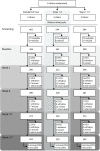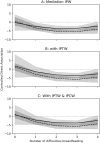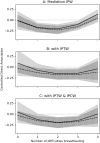Postpartum depressive symptoms following implementation of the 10 steps to successful breastfeeding program in Kinshasa, Democratic Republic of Congo: A cohort study
- PMID: 33428617
- PMCID: PMC7799755
- DOI: 10.1371/journal.pmed.1003465
Postpartum depressive symptoms following implementation of the 10 steps to successful breastfeeding program in Kinshasa, Democratic Republic of Congo: A cohort study
Abstract
Background: Social support and relevant skills training can reduce the risk of postpartum depression (PPD) by reducing the impact of stressors. The 10-step program to encourage exclusive breastfeeding that forms the basis of the Baby-Friendly Hospital Initiative (BFHI) provides both, suggesting it may lessen depressive symptoms directly or by reducing difficulties associated with infant feeding. Our objective was to quantify the association of implementing Steps 1-9 or Steps 1-10 on postpartum depressive symptoms and test whether this association was mediated by breastfeeding difficulties.
Methods and findings: We used data from a breastfeeding promotion trial of all women who gave birth to a healthy singleton between May 24 and August 25, 2012 in 1 of the 6 facilities comparing different BFHI implementations (Steps 1-9, Steps 1-10) to the standard of care (SOC) randomized by facility in Kinshasa, Democratic Republic of Congo. Depressive symptoms, a non-registered trial outcome, was assessed at 14 weeks via the Edinburgh Postnatal Depression Scale (EPDS). Inverse probability weighting (IPW) was used to estimate the association of BFHI implementations on depressive symptoms and the controlled direct association through breastfeeding difficulties at 10 weeks postpartum. A total of 903 mother-infant pairs were included in the analysis. Most women enrolled had previously given birth (76%) and exclusively breastfed at 10 weeks (55%). The median age was 27 (interquartile range (IQR): 23, 32 years). The proportion of women reporting breastfeeding difficulties at week 10 was higher in both Steps 1-9 (75%) and Steps 1-10 (91%) relative to the SOC (67%). However, the number of reported difficulties was similar between Steps 1-9 (median: 2; IQR: 0, 3) and SOC (2; IQR: 0, 3), with slightly more in Steps 1-10 (2; IQR: 1, 3). The prevalence of symptoms consistent with probable depression (EPDS score >13) was 18% for SOC, 11% for Steps 1-9 (prevalence difference [PD] = -0.08; 95% confidence interval (CI): -0.14 to -0.01, p = 0.019), and 8% for Steps 1-10 (PD = -0.11, -0.16 to -0.05; p < 0.001). We found mediation by breastfeeding difficulties. In the presence of any difficulties, the PD was reduced for both Steps 1-9 (-0.15; 95% confidence level (CL): -0.25, -0.06; p < 0.01) and Steps 1-10 (-0.16; 95% CL: -0.25, -0.06; p < 0.01). If no breastfeeding difficulties occurred in the population, there was no difference in the prevalence of probable depression for Steps 1-9 (0.21; 95% CL: -0.24, 0.66; p = 0.365) and Steps 1-10 (-0.03; 95% CL: -0.19, 0.13; p = 0.735). However, a limitation of the study is that the results are based on 2 hospitals randomized to each group.
Conclusions: In conclusion, in this cohort, the implementation of the BFHI steps was associated with a reduction in depressive symptoms in the groups implementing BFHI Steps 1-9 or 1-10 relative to the SOC, with the implementation of Steps 1-10 associated with the largest decrease. Specifically, the reduction in depressive symptoms was observed for women reporting breastfeeding difficulties. PPD has a negative impact on the mother, her partner, and the baby, with long-lasting consequences. This additional benefit of BFHI steps suggests that renewed effort to scale its implementation globally may be beneficial to mitigate the negative impacts of PPD on the mother, her partner, and the baby.
Trial registration: ClinicalTrials.gov NCT01428232.
Conflict of interest statement
The authors have declared that no competing interests exist.
Figures



References
-
- WHO/UNICEF. Baby-friendly hospital initiative: revised, updated, and expanded for integrated care. Geneva, Switzerland: WHO/UNICEF, 2009. - PubMed
Publication types
MeSH terms
Associated data
Grants and funding
LinkOut - more resources
Full Text Sources
Other Literature Sources
Medical

